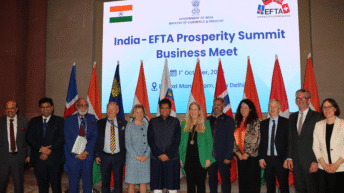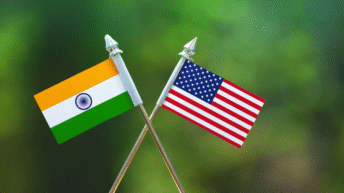
At 8.05 AM in the morning on 18 May 1974, IST India joined the exclusive club of nuclear-armed states when it exploded its first nuclear device with an estimated yield of around 8 kilotons of TNT. The test was carried out under the veil of secrecy at the Pokharan Test Range in the Thar Desert of Rajasthan. The operation was codenamed “Operation Smiling Buddha” – firstly because the test was conducted on the Buddha Purnima day, the birth anniversary of Gautam Buddha and secondly because Gautam Buddha is accepted as an embodiment of peace and India wanted the world to acknowledge the test as a peaceful nuclear explosion.
This test, nicknamed Happy Krishna by the United States military intelligence, positioned India as the sixth nation to test a nuclear weapon outside the five permanent UN Security Council members namely the United States, Soviet Union, United Kingdom, France, and China.
It was a highly secret operation and only a small group of scientists and military personnel were aware of the details, that too on a need to know basis. The nuclear device was assembled by a small group of scientists from the Bhabha Atomic Research Centre (BARC) and the Defence Research and Development Organisation (DRDO) led by Dr. Raja Ramanna.
It is reliably learnt that the then Prime Minister Indira Gandhi gave verbal orders to manufacture the nuclear device and prepare for a test while visiting the Bhabha Atomic Research Centre (BARC) on 7 September 1972. That was the starting point and since that day work began to craft the explosive device as well as locating, surveying, and preparing a suitable test site for what was formally dubbed the “Peaceful Nuclear Explosion” or PNE. However, very few records were kept, either on the development process or the decision-making involved in its construction and testing to preserve secrecy.
Dr Raja Ramanna, then director of BARC was designated as the primary leader of the project. He worked along with Dr. Basanti Dulal Nag Chaudhuri, director of DRDO to put together and coordinate the team for developing the explosive device. Dr. P.K. Iyengar, Ramanna’s second in command at BARC played a key role in the design and assembly of the plutonium implosion device and in overcoming the technical challenges of the test. Dr. R. Chidambaram who later became the Chairman of the Atomic Energy Commission of India contributed significantly to the success of Operation Smiling Buddha. Dr. Homi N. Sethna the Chairman of the Atomic Energy Commission at that time provided strategic oversight and ensured the project received the necessary resources and support. Dr. N.S. Venkatesan and his team at the Terminal Ballistics Research Laboratory (TBRL) Chandigarh played a key role in the design and engineering of the nuclear device, particularly the high explosive implosion mechanism. Apart from them Dr. M.R. Srinivasan, Dr. P. K. K. Menon and Dr. C.N.R. Rao played a key role at various stages of the nuclear test project. These scientists, along with many unnamed engineers, technicians, and support staff, collectively brought Operation Smiling Buddha to fruition.
Apart from the scientists working on the project, only a handful of people including Prime Minister Indira Gandhi, her trusted adviser P.N. Haksar, and her principal secretary D.P. Dhar were informed. Even Defence Minister Babu Jagjivan Ram, External Affairs Minister Swaran Singh, Indian army chief, General G. G. Bewoor, and Army commander Western Command Lt General T. N. Raina was informed only a few hours before the nuclear explosion.
The device, a plutonium implosion-type fission bomb, was transported to the Pokharan Test Range in Rajasthan, where meticulous preparations were made for the test. The site was selected for its remote location, ensuring minimal risk to civilian populations and limited visibility to prying eyes.
The task of digging the 107 metres deep underground shaft for the test was assigned to the 61st Engineering Regiment stationed in Jodhpur and commanded by Lt. Col. Subherwal who ignored Ramanna’s requests till PM Indira Gandhi herself intervened. Finally Gen. Bewoor ordered the unit to begin the shaft construction project code-named Operation Dry Enterprise but there was a problem initially as the unit had no prior experience in digging shafts. Eventually the digging of the shaft was completed only days before the 18 May test after initial difficulties.
The test was originally scheduled for 8 a.m. but got delayed because V.S. Sethi, an engineer from the Terminal Ballistics Research Laboratory (TBRL), tasked to check the high speed cameras, was stranded at the test site because his jeep didn’t start. Sethi hiked out in time for the test as scheduled, but the army’s efforts to recover the jeep delayed the shot. Finally the device was detonated by Pranab Rebatiranjan Dastidar from BARC who pushed the firing button at 8.05 IST on 18 May 1974.
The explosion created a crater and a mushroom cloud, demonstrating the technical and scientific capabilities of the Indian team.
Prime Minister Indira Gandhi, described it as a peaceful nuclear explosion, emphasising India’s commitment to peaceful uses of nuclear energy as well as a necessary step for national security and scientific progress.
Operation Smiling Buddha had profound implications for India’s nuclear policy and marked the beginning of India’s journey as a nuclear-armed state.
Scientific and Technological Achievements
Operation Smiling Buddha showcased India’s scientific and technological capabilities, marking a significant achievement for the country’s research and development community. The success of the nuclear test was a testament to the dedication and ingenuity of Indian scientists and engineers who worked under challenging conditions to reach a complex technological milestone.
The test also had a transformative impact on India’s nuclear energy programme, boosting research and development in various fields of nuclear science and technology. The knowledge and expertise gained from the test contributed to advancements in nuclear power generation, medical applications, and industrial uses of nuclear technology.
In recognition of their efforts Ramanna, Setha, and Nag Chaudhuri were awarded Padma Vibhushan — India’s second-highest civilian award in 1975, while Iyengar, Chidambaram, Venkatesan, Dastidar, and Seshadri were awarded Padma Shri the fourth highest award.
The legacy of Smiling Buddha was further cemented with the Pokharan-II tests in May 1998, under the leadership of Prime Minister Atal Bihari Vajpayee when India conducted a series of nuclear tests and openly declared itself a nuclear weapons state. These tests were a direct continuation of the efforts and aspirations that began with Operation Smiling Buddha.
Commemoration and Legacy
As we commemorate the 50th anniversary of Operation Smiling Buddha, it is essential to recognise the multifaceted legacy of this historic event as a defining moment in India’s journey towards self-reliance, symbolising the nation’s resolve to protect its sovereignty.
It is also an opportunity to celebrate the achievements of the scientists and engineers who made the test possible and contributed to India’s scientific and technological progress. It is also a moment to reflect on the broader implications of nuclear weapons and the importance of pursuing a balanced approach to national security and international stability.
Conclusion
Operation Smiling Buddha was a watershed moment in India’s history, as a significant player on the global stage.
Fifty years on, the legacy of Smiling Buddha continues to serve as a reminder of the importance of scientific innovation, national security, and technological breakthroughs. The achievements of Operation Smiling Buddha continue to lead India towards a secure and prosperous future.






Add comment